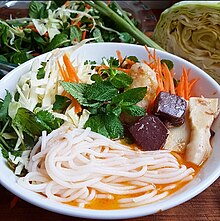Khao poon
 | |
| Alternative names | Lao royal vermicelli curry soup, laksa |
|---|---|
| Type | Soup |
| Place of origin | Laos |
| Main ingredients | Rice vermicelli,meat (chicken,fish,orpork),fish sauce,padaek,lime leaves,galangal,garlic,shallots,Lao chillies |
| Variations | Khao poon nam phik, khao poon nam jaew |
Khao poon(Lao:ເຂົ້າປຸ້ນ,pronounced[kʰà(ː)wpûn]); also known asLao royal vermicelli curry souporLao laksaand sometimes spelledkapoon, khao pounorkhao pun) is a popular national noodle soup of Laos.[1]Khao poonis one type ofLaorice vermicellisoup[2]that is often made with poundedchicken,fish,orporkin coconut milk broth (or without coconut milk) and seasoned with common Lao ingredients such asfish sauce,padaek,lime leaves,galangal,garlic,shallots,Lao chillies, andfish mint.Different versions of the dish are also in Malaysia, Thailand, Indonesia, Cambodia, Singapore, and the United States.
The process of makingkhao pooncould have been brought by the Lao ancestors as they migrated into theGreater Mekong Subregionfrom Southern China. It is also likely that thekhao poonnoodles were introduced to Laos by Chinese merchants becauseLuang PrabangandVientianewas part of an ancient trade route with China.[3]Laotians had been makingkhao poonnoodles soup for sale at the market and for their own consumption long before the French arrived in Laos in the 1800s.[4]
Coconut milk curry was probably introduced to Laos during the indianization of the LaoLan Xang kingdomin the fourteen century by the Khmer,[5]Indian merchants,[6]or even as early as the seventh century by Buddhist monks.[7]Several centuries later Lan Xang would signed a contract with theDutch East Indian Company[8]and trade directly with the world through the ports of Cambodia.[9][10]
Khao poonis often described as Lao royal vermicelli coconut curry soup due to its bright red and golden colors representing the colors of the Lao royal family.
The traditional recipes for different types ofkhao poonserved to Laotian royals can be found in a collection of hand written recipes fromPhia Sing(1898-1967), the king's personal chef and master of ceremonies. Phia Sing's hand written recipes were complied and published for the first time in 1981.[11]
American writer and filmmakerHarry Hervey(1900-1951) describedkhao poonas a kind of macaroni in broth in his account of a dinner offered by the Lao prince Phetsarath Rattanavongsa (1890-1959) in Luang Prabang, Laos, during his travel to French Indochina in the 1920s.[12]According toAlfred Raquez(1862-1907), a French phographer and writer, who visited Laos at the beginning of 1900, this Lao macaroni soup was sold in the markets of Luang Prabang.[13]During the 1950s, André-Yvette Gouineau,[14]the famous French resistance fighter and France's national hero, was a professor at lychee de Vientiane, Laos. While in the Laos, Gouineau collected several traditional Lao recipes includingkhao poon.Gouineau describedkhao poonas a "dish of vermicelli served with raw vegetables and a special sauce; it is very nourishing."[15]
Gouineau's recipe echoed Phia Sing's recipe forkhao poon nam phrik.The two recipes consisted of using already cooked pork and fish combined and mashed in a pestle and mortar with spices and herbs before adding the mixture to freshly squeezed coconut milk, padaek, and broth. The dish is served with finely sliced banana flower, bean sprouts and mint. The final plating ofkhao poonwas meticulously described in the recipe as "filling the bottom of the soup bowl with vermicelli, add several pitches of the various raw vegetables according to their taste and preferences and bathe the whole with a generous helping of the creamy sauce".[15]
Various versions ofkhao poonexist:
Khao poon nam phik,also calledkhao poon nam kathee(with coconut milk)
Khao poon nam jaew(without coconut milk),khao poon nam par(with fish sauce)
Khao poon nam ped- Lao duck vermicelli curry noodle Soup
Khao poon nam paa- Lao fish vermicelli curry noodle Soup
Khao poon nam gai- Lao chicken vermicelli curry noodle Soup
See also[edit]
- Mee ka tee
- Bún(Vietnam)
- Laksa(Indonesia, Malaysia, Singapore)
- List of soups
- Rice noodles
- Rice vermicelli
References[edit]
- ^Souvannaphouma, Mangkra.Laos(in French). Editions L'Harmattan.ISBN978-2-296-59040-3.
- ^Webb, L.S.; Cardella, L.G. (2009).The Multicultural Cookbook for Students, 2nd Edition.EBL-Schweitzer. ABC-CLIO. p. 93.ISBN978-0-313-37559-0.RetrievedJanuary 23,2019.
- ^Tan, Danielle (2015)."Chinese Engagement in Laos: Past, Present, and Uncertain Future".Trends in Southeast Asia:VII–VIII.doi:10.1355/9789814620895-002.ISBN9789814620895.
- ^Massie, Victor-Alphonse (1894).Dictionnaire français-laotien: Mission Pavie, exploration de l' indochine (Latin characters).p. 124.
- ^Carter, Alison Kyra (2010)."Trade and Exchange Networks in Iron Age Cambodia: Preliminary Results from a Compositional Analysis of Glass Beads"(PDF).Bulletin of the Indo-Pacific Prehistory Association.30:178–188.doi:10.7152/bippa.v30i0.9966.ISSN1835-1794.
- ^"History of Laos | Asia Highlights".www.asiahighlights.com.Retrieved2021-06-27.
- ^Kochhar, Atul (2015-12-17).Atul's Curries of the World.Bloomsbury Publishing.ISBN978-1-4729-3277-8.
- ^Karlström, Anna (2009).Preserving impermanence: the creation of heritage in Vientiane, Laos.Uppsala University, Department of Archaeology and Ancient History.ISBN978-91-506-2077-1.OCLC489130116.
- ^Tăng nguyên, thiện chi (2017-03-30).On the relocation of the capital of the Lan Xang Kingdom (Laos) in the sixteenth century.OCLC1059931474.
- ^van Krieken-Pieters, Juliette (2010).Van Wuysthoff and the Lan Xang Kingdom: a Dutch merchant's visit to Laos in 1641.Ginkgo Publishers.ISBN978-90-71256-15-8.OCLC701050985.
- ^"Lao Recipes".www.seasite.niu.edu.Archived fromthe originalon 2012-03-10.Retrieved2021-06-27.
- ^Hervey, Harry (2013).King Cobra, Mekong Adventures in French Indochina.DatAsia Press. pp. 222–223.ISBN978-1-934431-82-5.
- ^Raquez, Alfred (1902).Pages Laotiennes: Le haut-Laos - le moyen-Laos - le bas-Laos.F. H. Schneider, Hanoi. p. 183.
- ^"Musée de la résistance en ligne".museedelaresistanceenligne.org.Retrieved2021-06-27.
- ^abde Berval, René (1959).Kingdom of Laos: the land of the million elephants and of the white parasol.France-Asie.OCLC3144283.
